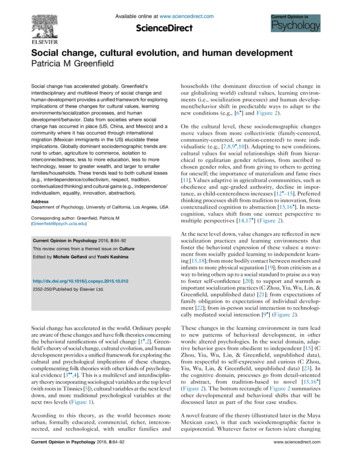
Transcription
7775CULTURAL CHANGE, SLOW AND FAST:THE DISTINCTIVE TRAJECTORY OFNORMS GOVERNING GENDER EQUALITYAND SEXUAL ORIENTATION*IntroductionAs we have seen, high levels of economic and physical security encourage a shift from Materialist to Postmaterialist values. This makes people more favorable to a variety social changes, ranging from greateremphasis on environmental protection to democratization. It is alsobringing growing acceptance of gender equality and homosexuality.1Throughout history, most societies instilled norms limitingwomen to the roles of wife and mother, and stigmatizing homosexuality and any other sexual behavior not linked with reproduction.2High levels of security bring growing acceptance of gender equalityand other behavior that was discouraged by agrarian societies, whichrequire high fertility rates to maintain their populations. During thepast century these cultural norms have been changing slowly in highincome societies, mainly through intergenerational population replacement – but this process recently reached a threshold at which rapidcultural change began, leading to major societal-level changes such asgrowing numbers of women holding positions of authority and thelegalization of same-sex marriage.* This chapter is based on Inglehart, Ponarin and Inglehart, 2017.Downloaded from https://www.cambridge.org/core. Loyola Notre Dame, on 28 Apr 2022 at 19:09:02, subject to the Cambridge Core terms of use,available at https://www.cambridge.org/core/terms. https://doi.org/10.1017/9781108613880.006
788778 / Cultural Change, Slow and FastAdvanced industrial societies no longer require high fertilityrates, and they have dropped sharply. Effective birth control technology, labor-saving devices, improved childcare facilities and very lowinfant mortality make it possible for women to have full-time careersand children – with or without a husband. Traditional Pro-fertilitynorms are no longer needed and they are giving way to Individualchoice norms, which allow people to choose their own behavior.But basic cultural norms don’t change immediately. As thepersistence of religion demonstrates, they generally change slowly.Although leading nineteenth-century social theorists agreed that religion was heading toward extinction, a larger share of the world’s population held traditional religious values in 2004 than in 1980.3 But, aswe will see, norms concerning gender equality, divorce, abortion, andhomosexuality are now changing with remarkable speed, although thisshift from Pro-fertility norms to Individual-choice norms is opposed byvirtually all major religions.People are reluctant to give up traditional norms governing gender equality and sexual behavior, as is evident from persistentopposition to abortion, same-sex marriage and gender equality even insuch economically secure societies as the USA. Adherence to traditionallifestyle norms is stronger still in countries suffering from insecure conditions that make people cling to familiar norms. But when a societyattains high levels of existential security, and survival comes to be takenfor granted, people become increasingly open to new norms.If economic development is conducive to the emergence ofindividual-choice norms, we would expect these norms to be morewidespread among the publics of rich countries than poor ones –whichis precisely what we find.When a society reaches a sufficiently high level of economic andphysical security that younger birth cohorts grow up taking survivalfor granted, it launches an intergenerational shift from survival-normsto individual-choice norms. But the effects of reaching this thresholddo not manifest themselves immediately: until they reach adulthood,the birth cohorts formed under the new conditions have little influence.Even when they begin to enter adulthood, they are still a minority andit takes additional decades before they become a majority of the adultpopulation. Consequently, we are not dealing with a phenomenon inwhich economic growth in one year brings a corresponding increasein emphasis on individual-choice norms the next year. Instead, we areDownloaded from https://www.cambridge.org/core. Loyola Notre Dame, on 28 Apr 2022 at 19:09:02, subject to the Cambridge Core terms of use,available at https://www.cambridge.org/core/terms. https://doi.org/10.1017/9781108613880.006
799779 / Introductiondealing with a process of intergenerational population replacementthat may reflect thresholds reached forty or fifty years earlier.Nevertheless, intergenerational population replacement hasgradually made individual-choice norms increasingly acceptable inhigh-income societies – and they seem to have reached a tipping pointat which the prevailing outlook shifts from rejection to acceptance ofnew norms. At this point, the influence of conformism reverses polarity: instead of inhibiting tolerant attitudes, it encourages them, sharplyaccelerating the pace of cultural change.Thus when a society attains high levels of existential security,rapid cultural changes can occur – but this happens only after a lag ofseveral decades between the time when secure conditions emerge, andthe time when new norms become predominant. For example, Westerneconomic miracles, welfare states and the Long Peace all emerged fairlysoon after 1945. But the political consequences of these events only beganto manifest themselves twenty years later, when the first postwar birthcohort became politically relevant as young adults: the Student ProtestEra erupted in 1968, when those born from 1945 to 1955 were in theirteens and early twenties.4 Student protest in advanced industrial societiescontinued throughout the 1970s but was still a minority phenomenon thatevoked strong negative reactions. But by the 1980s, the older members ofthe postwar birth cohorts were in their thirties and forties, occupying influential positions in society. By the 1990s, Postmaterialists had become asnumerous as Materialists, and norms that were considered deviant in the1960s became politically correct. Conformist influences began to reversepolarity among growing segments of the adult population of high-incomecountries, bringing rapid cultural change. As we will demonstrate:1) These value changes involve very long time-lags between the onsetof the conditions leading to them, and the societal changes theyproduce. There was a time-lag of 40–50 years between whenWestern societies first attained high levels of economic and physical security after World War II, and the occurrence of such relevantsocietal changes as legalization of same-sex marriage.2) One distinctive set of norms concerning gender equality, divorce,abortion and homosexuality supports a pro-fertility strategy thatwas essential to the survival of pre-industrial societies but eventually became superfluous. This set of norms is now moving on atrajectory that is distinct from that of other cultural changes.Downloaded from https://www.cambridge.org/core. Loyola Notre Dame, on 28 Apr 2022 at 19:09:02, subject to the Cambridge Core terms of use,available at https://www.cambridge.org/core/terms. https://doi.org/10.1017/9781108613880.006
800880 / Cultural Change, Slow and Fast3) Although basic values normally change at the pace of intergenerational population replacement, the shift from Pro-fertility normsto Individual-choice norms has reached a tipping-point where conformist pressures have reversed polarity and are now acceleratingvalue changes they once resisted, bringing major societal changessuch as legalization of same-sex marriage.Theory and HypothesesOur analysis deals with two distinct phenomena:1. The first is a shift from “Pro-fertility Norms” (emphasizingtraditional gender roles and stigmatizing any sexual behaviornot linked with reproduction) to “Individual-Choice Norms”(supporting gender equality and tolerance of homosexuality). Decades ago, Lesthaeghe and Surkyn5 and Van de Kaa,6demonstrated that the intergenerational shift from Materialistto Postmaterialist values led to lower human fertility rates inWestern Europe. This chapter deals with another, more recentshift in societal norms concerning gender equality and toleranceof gays and lesbians. This cultural change has important political consequences, encouraging new legislation concerning genderand sexual orientation.2. The second phenomenon involves the speed of cultural change –which normally moves at the glacial pace of intergenerationalpopulation replacement. When the conditions shaping a society’syounger generation’s pre-adult years differ substantially from thoseshaping older groups, intergenerational value change occurs. Itproceeds with a multi-decade time-lag between the emergence ofthe societal conditions conducive to the change, and the time whena society as a whole has adopted new values.But the process can reach a tipping point at which prevailingopinion becomes favorable to the new norms and conformist pressuresreverse polarity. In high-income countries, the shift from Pro-fertilitynorms to Individual-choice norms recently reached this point. Insteadof resisting the effect of intergenerational population replacement, conformism now reinforces it, bringing rapid cultural change.Downloaded from https://www.cambridge.org/core. Loyola Notre Dame, on 28 Apr 2022 at 19:09:02, subject to the Cambridge Core terms of use,available at https://www.cambridge.org/core/terms. https://doi.org/10.1017/9781108613880.006
811881 / Theory and HypothesesThe Values Surveys have monitored norms concerning genderequality and sexual orientation in successive waves of surveys from1981 to 2014. Although deep-seated norms limiting women’s roles andstigmatizing homosexuality persisted from Biblical times to the twentieth century, these surveys now show dramatic changes in high-incomecountries from one wave to the next, with growing support for genderequality and tolerance of gays and lesbians.This is changing society. For most of recorded history, samesex marriage did not exist in large societies. In 2000 it was legalizedin The Netherlands, followed by a growing number of other countries.Similarly, until recently women were second-class citizens in most countries, not obtaining the vote (even in developed countries) until wellinto the twentieth century. In recent years, women have been elected totop political office in many countries.Cultural Evolution and the Shift to Individual-Choice NormsMany thousands of societies have existed, most of which are nowextinct. They instilled a wide variety of norms concerning genderequality and reproductive behavior. Some agrarian societies encouraged having large numbers of children, while others emphasized higherinvestment in fewer children. But all pre-industrial societies that survived for long, encouraged much high human fertility rates than thoseof today’s high-income societies. Preindustrial societies encouragedhigh fertility rates because they faced high infant mortality rates andlow life expectancies, making it necessary to produce large numbers ofchildren in order to replace the population. Even West European societies (which emphasized higher investment in fewer children), producedsix to eight children per woman.7 In striking contrast, contemporaryWest European societies now produce from 1.1 to 1.9 children.Economic factors reinforced the tendency for agrarian societies to have high fertility rates: having many children was economically beneficial, but as development proceeded, having many childrenbecame an economic liability.Not all pre-industrial societies encouraged high fertility rates.From Biblical times to the twentieth century, some societies (such asthe Shakers) required celibacy – but these societies have disappeared.Virtually all societies that survive as independent nations today,Downloaded from https://www.cambridge.org/core. Loyola Notre Dame, on 28 Apr 2022 at 19:09:02, subject to the Cambridge Core terms of use,available at https://www.cambridge.org/core/terms. https://doi.org/10.1017/9781108613880.006
822882 / Cultural Change, Slow and Fastinculcated gender roles and reproductive norms encouraging highfertility rates. Accordingly, the public of every low-income or lowermiddle-income society included in the Values Surveys – without a singleexception – places relatively strong emphasis on Pro-fertility norms.These norms encourage women to cede leadership roles to men anddevote themselves to bearing and raising children. They also stigmatizeany form of sexual behavior that is not linked with reproduction, suchas homosexuality, abortion, divorce or masturbation.In some countries the daughters or widows of kings, fromCleopatra to Catherine the Great, could inherit the throne, with onewoman ruling the country while the rest were second-class citizens.Because tiny numbers of women were involved, this had a negligibleimpact on the society’s human fertility level, making it compatible withtraditional Pro-fertility norms. Much more recently, women’s suffragemovements emerged, with women winning the right to vote around1920 in historically Protestant democracies and around 1945 in historically Catholic democracies. This was a major advance, but allowingwomen to vote once every few years still had little impact on fertilityrates. Traditional Pro-fertility norms began to erode noticeably in the1960s and 1970s when the post-war birth cohorts first became politically relevant.Rising Existential Security and Cultural ChangeSurvival has become increasingly secure. Life expectancies, incomesand school attendance rose from 1970 to 2010 in every region of theworld.8 Poverty, illiteracy and mortality are declining globally.9 Andwar, crime rates and violence have declined dramatically for manydecades.10The world is now experiencing the longest period withoutwar between major powers in recorded history. This, together with thepostwar economic miracles and the emergence of the welfare state, produced conditions under which a large share of those born since 1945in Western Europe, North America, Japan, Australia and New Zealandgrew up taking survival for granted, bringing intergenerational shiftstoward Postmaterialist values and Self-expression values (as Chapter 2demonstrated). Most societies no longer require high fertility rates,which have dropped dramatically – especially in high-income societiesDownloaded from https://www.cambridge.org/core. Loyola Notre Dame, on 28 Apr 2022 at 19:09:02, subject to the Cambridge Core terms of use,available at https://www.cambridge.org/core/terms. https://doi.org/10.1017/9781108613880.006
833883 / Theory and Hypotheseswhere life-expectancy rates have almost doubled in the past century11and infant mortality rates have fallen to one-thirtieth of their 1950level.12 For many years, it has no longer been necessary to women toproduce six to eight children in order to replace the population.But deep-rooted cultural norms change slowly. Virtually allmajor world faiths emphasize pro-fertility norms – and they do so vigorously. Pro-fertility norms are not presented as matters of individualjudgment. They are held to be absolute values, violation of which willbring eternal damnation. It was necessary to make these cultural sanctions strong because Pro-fertility norms require people to suppressstrong natural urges. “Thou shalt not commit adultery” goes againstdeep-rooted desires; requiring women to devote their lives to childbearing and child-rearing entails major sacrifices; and defining homosexuality as sinful, unnatural behavior imposes severe self-repressionand self-hatred on gays and lesbians.These norms are no longer necessary for societal survival, butdeep-rooted values resist change. Nevertheless, modernization bringshigh levels of economic and physical security.13 People grow up takingsurvival for granted, making them increasingly open to new ideas. AsChapters 3 and 4 demonstrated, Self-expression values – which includetolerance of homosexuality – have become widespread in societies withsecure living conditions.Evolutionary Modernization TheoryEvolutionary modernization theory argues that the degree to whichpeople experience threats to their survival has pervasive effects ontheir society’s cultural norms. Western Europe’s postwar economicmiracles and welfare states led to the emergence of a predominantlyPostmaterialist generation born after 1945, but this generation did notbecome politically visible until 20 years later, when they reached adulthood – contributing to the student protest era of the late 1960s and1970s. At that point, there was a huge gap between the values of thisfirst postwar birth cohort and all older cohorts.But the 20-year-olds eventually became 30-year-olds and then40-year-olds and then 50-year-olds. As postwar birth cohorts replacedolder cohorts, their values gradually spread. Today, Western Europe’ssocial norms are profoundly different from those of 1945. In 1945,Downloaded from https://www.cambridge.org/core. Loyola Notre Dame, on 28 Apr 2022 at 19:09:02, subject to the Cambridge Core terms of use,available at https://www.cambridge.org/core/terms. https://doi.org/10.1017/9781108613880.006
844884 / Cultural Change, Slow and Fasthomosexuality was still criminal in most West European countries; itis now legal in virtually all of them. Church attendance has declineddramatically, fertility rates have fallen below the replacement level,and women have won high political office. But there was a time-lag of40 to 50 years between the onset of the conditions conducive to thesechanges, and the point where new values were accepted by society asa whole.The long time-lags between the onset of conditions conduciveto deep-rooted cultural changes and the time when they transform asociety means that current socioeconomic conditions don’t explain current cultural changes. The intergenerational shift to Individual-choicenorms in Western countries has now attained enough momentum that itseems unlikely to reverse itself. But, as we have seen, these countries arecurrently experiencing economic stagnation, rising inequality and highunemployment, which is often blamed on massive immigration. Manyrecent immigrants are Islamic and hostility to them is compounded byhighly publicized Islamic terrorism. Today, women and gays do notseem threatening, but Muslim immigrants do. Accordingly, in recentyears, ethnocentric populist parties have won unprecedentedly largeshares of the vote in national elections. Clearly, not all aspects of cultural change are moving at the same pace.In pre-industrial societies, tolerance of abortion, homosexuality and divorce remains extremely low and conformist pressures inhibitpeople from expressing tolerance. In Egypt, for example, fully 99 percent of the public condemned homosexuality in recent surveys – whichmeans that even the homosexuals were condemning homosexuality.But intergenerational population replacement has graduallymade individual-choice norms increasingly acceptable in high-incomesocieties – initially among the student population and then amongsociety as a whole. A tipping point is being reached where the prevailing outlook shifts from rejection to acceptance of new norms,and instead of inhibiting tolerant attitudes, conformism and socialdesirability begin to encourage them. As attitudes become more tolerant, gays and lesbians come out. Growing numbers of people realizethat some of the people they know and like are gay, leading them tobecome more tolerant – encouraging more gays to come out, in apositive feedback loop.14In short, when a society attains high levels of existential security and people grow up taking survival for granted, rapid culturalDownloaded from https://www.cambridge.org/core. Loyola Notre Dame, on 28 Apr 2022 at 19:09:02, subject to the Cambridge Core terms of use,available at https://www.cambridge.org/core/terms. https://doi.org/10.1017/9781108613880.006
855885 / Theory and Hypotheseschanges can occur – but this happens with a time-lag of several decadesbetween when secure conditions first emerge, and when new normsbecome predominant.HypothesesThis theory generates the following hypotheses:Hypothesis 1. A syndrome of Individual-choice norms exists, in whichthe publics of some societies endorse a coherent set of traditional Profertility norms, while the publics of others support a set of Individualchoice norms concerning gender equality and divorce, abortion andhomosexuality. Support or opposition to the various components ofthis syndrome go together.Hypothesis 2. High levels of existential security are conducive toIndividual-choice norms. The publics of societies with high per capitaGDP, high life expectancy and low infant mortality (the three indicators of existential security used here) will be likelier to supportIndividual-choice norms than those with low levels. Similarly, withingiven countries, the most secure strata will be likeliest to supportIndividual-choice norms.Hypothesis 3. Over the past 50 years, existential security levels haverisen substantially in developed countries, producing large differencesbetween the values of younger and older cohorts. Consequently, asyounger cohorts replace older ones, we should observe an intergenerational shift from Pro-fertility norms to Individual-choice norms.Hypothesis 4. Because this shift reflects the level of existential security that prevailed during the pre-adult years of people who were bornseveral decades ago, the strongest predictor of a society’s level of support for new values will not be its current levels of per capita GDP,life expectancy and infant mortality, but levels that prevailed severaldecades ago.Hypothesis 5. Although intergenerational population replacementinvolves long time-lags, cultural change can reach a tipping point atwhich new norms become perceived as dominant. Social desirabilityeffects then reverse polarity: instead of retarding the changes linkedDownloaded from https://www.cambridge.org/core. Loyola Notre Dame, on 28 Apr 2022 at 19:09:02, subject to the Cambridge Core terms of use,available at https://www.cambridge.org/core/terms. https://doi.org/10.1017/9781108613880.006
866886 / Cultural Change, Slow and Fastwith intergenerational population replacement, they accelerate them –bringing rapid cultural change.Hypothesis 6. When they become dominant, the new norms can havemajor societal-level consequences, such as gender quotas on electorallists, or legalization of same-sex marriage.Data and MethodsWe test these hypotheses against data from the Values Surveys, whichcover the full range of economic development, including 22 lowincome countries, 29 lower-middle income countries, 20 upper-middleincome countries and 28 high-income countries, as classified by theWorld Bank in 2000 (these countries are listed in Appendix A3.1).15The Values Surveys also cover all major cultural zones, including theFigure 5.1 Six aspects of tolerance, by level of economic development.Percentage expressing tolerant views on given topic. Question wording is shownin Table 5.1.The questions concerning divorce, abortion and homosexuality are measured on10-point scales, with codes 6 through 10 being coded as tolerant. The questionsconcerning gender equality have tolerant and intolerant responses. The countriesincluded in each category are listed in Appendix A3.1.Downloaded from https://www.cambridge.org/core. Loyola Notre Dame, on 28 Apr 2022 at 19:09:02, subject to the Cambridge Core terms of use,available at https://www.cambridge.org/core/terms. https://doi.org/10.1017/9781108613880.006
877887 / Data and Methodsmost populous countries in each group. The questions analyzed herewere asked in identical form in successive waves of these surveys.Our dependent variable is Individual-choice norms. Althoughvalue change occurs at the individual level, we are primarily interested in how this leads to societal-level changes. Value change doesnot automatically change a society’s laws and institutions, but it doesmake such changes increasingly likely. Individual-level cultural changeleads to societal-level change in two ways: first, democratic elites andinstitutions are necessarily responsive to mass preferences, but evenautocratic leaders are not immune to them. Moreover, because elitesgrow up within a given society, in the long run they tend to reflect itsprevailing norms.It is sometimes suggested that aggregating individual-leveldata to the societal-level is somehow tainted. This interpretation ismistaken. Over 60 years ago, in his classic article on the ecologicalfallacy, Robinson pointed out that the relationships between two variables at the individual level are not necessarily the same as those at theaggregate level.16 This is an important insight, but it does not meanthat aggregating is wrong – it simply means that one can’t assume thata relationship that holds true at one level also holds true at anotherlevel. Social scientists have been aggregating individual-level data toconstruct national-level indices such as fertility rates for so long thatthey seem familiar and legitimate – but they are no more legitimatethan aggregated subjective data. Its infant mortality rate is an important national-level attribute of any country – but all of the living ordying is done by individuals. Similarly, income inequality is a valid andmeaningful national-level variable, although it is based on the incomesof individuals.In this chapter, Individual-choice norms are measured at boththe individual level and the societal level. We happen to find similarcausal relationships at both levels: relatively secure individuals and relatively secure countries rank highest on these norms. But because thischapter focuses on how cultural change leads to sociopolitical changes,our key analyses are done at the societal level.Table 5.1 shows a national-level factor analysis that demonstrates that three questions concerning acceptance of divorce, abortion and homosexuality and responses to three questions concerningacceptance of gender equality have a strong tendency to go together.Each question’s factor loading shows how strongly responses toDownloaded from https://www.cambridge.org/core. Loyola Notre Dame, on 28 Apr 2022 at 19:09:02, subject to the Cambridge Core terms of use,available at https://www.cambridge.org/core/terms. https://doi.org/10.1017/9781108613880.006
88888 / Cultural Change, Slow and FastTable 5.1 Pro-fertility norms vs. individual-choice norms(Principal component factor analysis)Response:Homosexuality is never justifiableWhen jobs are scarce, men have more right to a jobthan womenDivorce is never justifiableOn the whole, men make better political leadersthan women doAbortion is never justifiableA university education is more important for a boythan for a girlFactor loading: .90 .89 .89 .88 .80 .78High positive scores indicate support for Individual-choice norms.Source: National-level data from 80 countries included in the Values Surveys.that question are correlated to an underlying Pro-fertility versusIndividual-choice dimension. Loadings around .90 indicate thatthey go together in an almost one-to-one relationship. The publicsof some societies tend to be strongly favorable to gender equality and relatively tolerant of divorce, abortion and homosexuality,while the publics of other societies tend to have unfavorable attitudes toward all six questions. Consequently, we used the responsesto these six questions to measure the extent to which a society (or anindividual) supports traditional Pro-fertility norms or Individualchoice norms.17Our key independent variable is an index of ExistentialSecurity, based on factor scores from a principal components analysisof each country’s levels of life expectancy, infant mortality and GDP/capita.18 They also tap a single dimension, showing loadings of .97,–.97 and .90 respectively in 1960. Reliable cross-national data areavailable since 1960, enabling us to construct this index at varioustime points.Although people who emphasize Individual-choice norms alsotend to emphasize Postmaterialist values, the shift from Pro-fertility toIndividual-choice norms shows distinctive behavior and is moving at amuch more rapid pace than the shift from Materialist to Postmaterialistvalues.19Downloaded from https://www.cambridge.org/core. Loyola Notre Dame, on 28 Apr 2022 at 19:09:02, subject to the Cambridge Core terms of use,available at https://www.cambridge.org/core/terms. https://doi.org/10.1017/9781108613880.006
899889 / Empirical Analyses and FindingsEmpirical Analyses and FindingsHypothesis 1. A syndrome of Individual-choice norms exists, in whichthe publics of some societies endorse traditional Pro-fertility norms,while others support Individual-choice norms concerning gender equality and divorce, abortion and homosexuality.As Table 5.1 demonstrates, acceptance or rejection of all sixindicators of Individual-choice norms does go together, with the publics of some societies being relatively favorable to gender equality,divorce, abortion and homosexuality, while others reject them. Onedimension emerges, with Pro-fertility norms and Individual-choicenorms at opposite poles.Hypothesis 2. High levels of existential security are conducive toIndividual-choice norms.As Figure 5.1 demonstrates, the publics of high-income countries are much likelier than those of low-income countries to hold tolerant attitudes toward all six indicators of Individual-choice norms.Averaged across the six items, in low-income countries only 38 percent of the public has tolerant attitudes, compared with 80 percentin high-income countries.20 These findings support the hypothesisthat high levels of existential security are conducive to Individualchoice norms – but before testing this hypothesis more conclusively,let us explore a key characteristic of our main independent variable,Existential Security:Hypothesis 3 holds that, in so far as societies have attained high levelsof existential security, su
But basic cultural norms don’t change immediately. As the persistence of religion demonstrates, they generally change slowly. Although leading nineteenth- century social theorists agreed that reli-gion was heading toward extinction, a larger share of the world’s pop-ulation held tra










